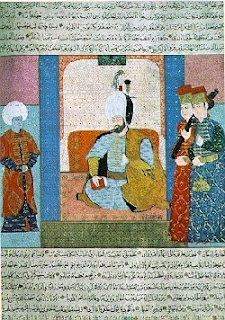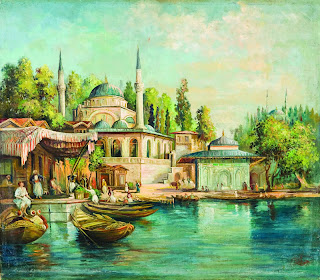Sultan Suleiman Era, Turkish Miniatures 2

In the East, during war and later peace with Iran, lead to continuous relations and has been one of the essential sources for influence and inspiration for Ottoman painters. Numerous eastern works and books were duplicated, reprinted, translated and illustrated. The accounting books of the time (Ehl-i Hiref books) show Iranians were the majority among palace artists. The miniature of Firdawsi of Bursa in his Suleimanname is a good example of the period.
Sultan Suleiman (The Magnificent) period is an important mark in the history of miniature. Regular recording of important historical events, wars, campaigns, celebrations, innovations, in and out going ambassadors etc started, and illustration of such books became customary. The palace officially started to employ writers and artists, and profession of sehname writing emerged. We can count Hamse of Nevai (TPM, H. 802), Divan of Nevai (TPM, R. 804), Tuhfet-el Ahrar among (TPM, R. 914) the most significant of these works.
 But, perhaps the most important work of the period is, without a doubt, Suleimanname of Arifi. It tells the Hungarian Siege of 1543, the conquest of Nice and the sea campaigns.
But, perhaps the most important work of the period is, without a doubt, Suleimanname of Arifi. It tells the Hungarian Siege of 1543, the conquest of Nice and the sea campaigns.In the spring of 1543, Ottoman naval forces set sail under the command of Barbaros Hayreddin, to aid François I of France. Barbaros or Barbarossa, reached Marseille after calling a number of Italian ports and joined the French armada. The joint forces took back Nice which was occupied by the Duke of Savois, an ally of Karl V at the time. Then the fleet went to Toulon to pass the winter. Along the way Barbarossa also freed Turgut Reis, who was a prisoner in Genoa, by threatening the burn down the entire city if he was not released.
Suleimanname describes all the events, ports called, the fleet, the important characters in detail.
Another important work of the time is Tarih-i Sultan Bayezid (TPM, R. 1272)which describes and depicts the sea campaigns of the time. The physical details of the places, geography, vessels, sea wars were vividly shown in the miniatures.
 Typically, these works are a continuation of a style first used by Matrakci Nasuh (see also How to (correctly) interpret Ottoman Calligraphy) in his masterpiece Beyan-i Menazil-i Sefer-i Irakeyn (IUL, T. 5964). Matrakci, or the Joker, describes the places visited during the Iraqi campaign of Sultan Suleiman. His miniatures are figureless, like a topographic scenery with all the details given. Towns like Eskisehir, Diyarbakir and Tabriz are like topographic paintings with the all the important buildings. But maybe the most important of them all is the miniature of Istanbul, which is the oldest picture of the city that we know.
Typically, these works are a continuation of a style first used by Matrakci Nasuh (see also How to (correctly) interpret Ottoman Calligraphy) in his masterpiece Beyan-i Menazil-i Sefer-i Irakeyn (IUL, T. 5964). Matrakci, or the Joker, describes the places visited during the Iraqi campaign of Sultan Suleiman. His miniatures are figureless, like a topographic scenery with all the details given. Towns like Eskisehir, Diyarbakir and Tabriz are like topographic paintings with the all the important buildings. But maybe the most important of them all is the miniature of Istanbul, which is the oldest picture of the city that we know.TPM: Topkapi Palace Museum
IUL: Library of Istanbul University
Part 1 Part 2 Part 3



Comments
Post a Comment